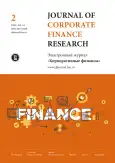Do Investors Pay Yield Premiums On Green Bonds?
- Autores: Mikhaylova A., Ivashkovskaya I.
- Edição: Volume 14, Nº 2 (2020)
- Páginas: 7-21
- Seção: New Research
- URL: https://journal-vniispk.ru/2073-0438/article/view/303079
- DOI: https://doi.org/10.17323/j.jcfr.2073-0438.14.2.2020.7-21
- ID: 303079
Citar
Texto integral
Resumo
Global shifts in perspectives on environmental concerns and the growing significance of large-scale sustainability programs have brought the issue of green financing to the fore of financial research. In terms of volume, this area has demonstrated high growth rates in various types of capital markets. Unfortunately, few studies exist which explore the yields on green bonds in emerging markets in comparison to developed ones. As such, in this paper, we contribute new evidence to the field of green financing and outline several
major differences between green issues in these types of capital markets. We study yield premiums of green bonds on a sample of 2,450 green issues and comparable traditional bonds over the period from 2008 to March 2020. We contribute to the literature by new empirical evidence on green financing. Our results provide evidence of small but statistically significant negative premiums on green bonds of 23,4%1 compared to the expected yields for standard issues. We also show that the negative premium on green bonds is more pronounced in developed markets (- 27%2) than in emerging ones (18%3). Moreover, we provide new evidence on the negative premium-liquidity relationship. Our research concludes that negative premiums are related to a higher level of liquidity:
green bonds have lower bid-ask spreads and a higher level of liquidity than traditional ones. These conclusions can assist investors, potential issuing companies, and public authorities in achieving a better understanding of the current situation of the green bond market in global terms.
Palavras-chave
Sobre autores
A. Mikhaylova
Autor responsável pela correspondência
Email: a.y.mikhaylova@mail.ru
I. Ivashkovskaya
Email: iivashkovskaya@hse.ru
Bibliografia
- Zerbib O. D. The effect of pro-environmental preferences on bond prices: Evidence from green bonds. Journal of Banking & Finance. 2019;98:39-60. doi: 10.1016/j.jbankfin.2018.10.012.
- Reboredo J. C. Green bond and financial markets: Comovement, diversification and price spillover effects. Energy Economics. 2018;74:38-50. doi: 10.1016/j.eneco.2018.05.030.
- Karpf A., Mandel A. Does it pay to be green? A comparative study of the yield term structure of green and brown bonds in the US municipal bonds market. SSRN Electronic Journal. 2017. doi: 10.2139/ssrn.2923484.
- Gianfrate G., Peri M. The green advantage: Exploring the convenience of issuing green bonds. Journal of Cleaner Production. 2019;219:127-135. doi: 10.1016/j.jclepro.2019.02.022.
- Preclaw R., Bakshi A. The cost of being green. Barclays Research. 2015. URL: https://www.environmental-finance.com/assets/files/US_Credit_Focus_The_Cost_of_Being_Green.pdf.
- Nanayakkara M., Colombage S. Do investors in green bond market pay a premium? Global evidence. Applied Economics. 2019;51(40):4425-4437. doi: 10.1080/00036846.2019.1591611.
- Partridge C., Medda F. R. The evolution of pricing performance of green municipal bonds. Journal of Sustainable Finance & Investment. 2020;10(1):44-64. doi: 10.1080/20430795.2019.1661187.
- Fatica S., Panzica R., Rancan M. The pricing of green bonds: Are financial institutions special? JRC Working Papers in Economics and Finance. 2019;(7). URL: https://publications.jrc.ec.europa.eu/repository/bitstream/JRC116157/jrc116157_faticapanzicarancan_gbpricing_jrc_report_01.pdf.
- Chiesa M., Barua S. The surge of impact borrowing: The magnitude and determinants of green bond supply and its heterogeneity across markets. Journal of Sustainable Finance and Investment. 2019;9(2):138-161. doi: 10.1080/20430795.2018.1550993.
- Bachelet M. J., Becchetti L., Manfredonia S. The green bonds premium puzzle: The role of issuer characteristics and third-party verification. Sustainability. 2019;11(4):1098. doi: 10.3390/su11041098.
- Febi W., Schäfer D., Stephan A., Sun C. The impact of liquidity risk on the yield spread of green bonds. Finance Research Letters. 2018;27:53-59. doi: 10.1016/j.frl.2018.02.025.
- Garay U., González M., Rosso J. Country and industry effects in corporate bond spreads in emerging markets. Journal of Business Research. 2019;102:191-200. doi: 10.1016/j.jbusres.2017.09.021.
- Bao J., Hou K. De facto seniority, credit risk, and corporate bond prices. The Review of Financial Studies. 2017;30(11):4038-4080. doi: 10.1093/rfs/hhx082.
- Lu C.-W., Chen T.-K., Liao H.-H. Information uncertainty, information asymmetry and corporate bond yield spreads. Journal of Banking & Finance. 2010;34(9):2265-2279. doi: 10.1016/j.jbankfin.2010.02.013.
- Zhou R., Xiong Y., Liu T., Li J. Macroeconomic determinants of credit spreads: An empirical comparison between Chinese and American corporate bonds. Asian Economic and Financial Review. 2019;9(5):604-616. doi: 10.18488/journal.aefr.2019.95.604.616.
- Chen T., Liao H., Tsai P. Internal liquidity risk in corporate bond yield spreads. Journal of Banking & Finance. 2011;35(4):978-987. doi: 10.1016/j.jbankfin.2010.09.013.
- Mukherjee K. Demystifying yield spread on corporate bonds trades in India. Asia-Pacific Financial Markets. 2019;26(2):253-284. doi: 10.1007/s10690-018-09266-w.
- Friewald N., Nagler F. Over-the-counter market frictions and yield spread changes. The Journal of Finance. 2019;74(6):3217-3257. doi: 10.1111/jofi.12827.
- Rojahn J., Zechser F. The effect of corporate diversification on credit risk: New evidence from European credit default swap spreads. Accounting and Finance. 2019;59(4):2679-2704. doi: 10.1111/acfi.12306.
- Guidolin M., Orlov A., Pedio M. The impact of monetary policy on corporate bonds under regime shifts. Journal of Banking & Finance. 2017;80:176-202. doi: 10.1016/j.jbankfin.2017.03.011.
- De Santis R. A. Unobservable country bond premia and fragmentation. Journal of International Money and Finance. 2018;82:1-25. doi: 10.1016/j.jimonfin.2017.12.003.
- Pereira J., Sorwar G., Nurullah M. What drives corporate CDS spreads? A comparison across US, UK and EU firms. Journal of International Financial Markets, Institutions and Money. 2018;56:188-200. doi: 10.1016/j.intfin.2018.02.002.
Arquivos suplementares










